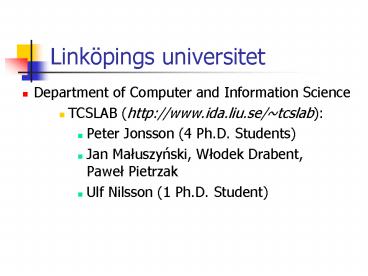Link - PowerPoint PPT Presentation
1 / 19
Title:
Link
Description:
Jan Maluszynski, Wlodek Drabent, Pawel Pietrzak. Ulf Nilsson (1 Ph.D. Student) ... CSP with disjunction. TCSLAB: Ulf Nilsson. Modeling and verification using CLP ... – PowerPoint PPT presentation
Number of Views:27
Avg rating:3.0/5.0
Title: Link
1
Linköpings universitet
- Department of Computer and Information Science
- TCSLAB (http//www.ida.liu.se/tcslab)
- Peter Jonsson (4 Ph.D. Students)
- Jan Maluszynski, Wlodek Drabent, Pawel
Pietrzak - Ulf Nilsson (1 Ph.D. Student)
2
TCSLAB Peter Jonsson
- Complexity
- Temporal spatial problems
- CSP with disjunction
- Algorithms
- Fast algorithms (theory practice)
- Unusual models
- Quantum computing
- DNA computing
3
TCSLAB Ulf Nilsson
TCSLAB Ulf Nilsson
- Teaching (C)LP
- 3rd year Logic Programming course (LP textbook
available free of charge on-line) - PhD courses on Constraint programming (with
J.M.) - www.ida.liu.se/ulfni/teaching.shtml
- Modeling and verification using CLP
- Local and symbolic model checking using tabled
CLP - Fault isolation in robot control software
- Verification of parameterized systems using
regular sets
4
Locating Errors in Constraint Logic Programs
- Wlodek Drabent, Jan Maluszynski, Pawel Pietrzak
- Department of Computer and Information Science
- Linköpings universitet
- wdr, jmz, pawpi_at_ida.liu.se
5
- What
- locating type errors in untyped CLP programs
- How
- directional types checking ? verifying the
program w.r.t. type specification
6
Symptoms and errors
- Symptom a discrepancy between users
expectations and actual program behavior - here wrong answers or illegal calls
- Error a part of the program responsible for the
symptom here prefixes of program
clauses
7
The diagnosis problem
- Find an error responsible for the symptom
- Traditional aprroaches
- Testing and tracing
- Type checking
- Problems with the CLP case
- Involved control and data flow
- CLP languages usually untyped
8
The approach
- Static analysis computes types T of predicate
arguments on call and on success, e.g. - Call-type nqueens(nat, any)
- Success-type nqueens(nat, list(nat))
- Inspection of T by the user results in
specification of expected types S . - Automatic error location based on S.
9
The types
- So far in logic programming (descriptve) types
are sets of terms. We extend them to - describe sets of constrained terms anyfd
- handle type parameters e.g.
- Call-type append(list(A),list(A),any)
- Succ-type append(list(A),list(A),list(A))
10
The types (contd)
- New types defined using parametric regular term
grammars by the user, or by the type inference
tool - tree(A) -gt void t(A,tree(A),tree(A))
- t(2,void,void) is in the type tree(nat)
- The standard type constructor list
- e.g. list(int), list(anyfd)
11
The structure of our tool
12
Diagnosis
- Works interactively
- Initial input
- CLP program
- Inferred types (Analyser)
- Diagnosis request (User)
- Interactions
- Query intended type (Diagnoser)
- Answer to the query (User)
- Output incorrect clause and atom
13
N-queens
- -entry nqueens(int,any).
- nqueens(N,L)- length(L,N), L1..N,
constrain_queens(L), labeling(L,0,most_constra
ined,indomain). - constrain_queens().
- constrain_queens(XY)- safe(X,Y,1),
constrain_queens(Y). - safe(_,,_).
- safe(X,YT,K)- noattack(X,Y,K),
- K1 is K1, safe(T,Y,K1). lt- bug here
- noattack(X,Y,K)- X \ Y, Y \ XK, X \ YK.
14
The inferred types
- Call-Type nqueens(int, any)
- Succ-Type nqueens(nat, t66)
- t66 --gt natt49
- t49 --gt
- -------------------------
- Call-Type constrain_queens(list(anyfd))
- Succ-Type constrain_queens(t60)
- t60 --gt
- t60 --gt anyfdt49
- t49 --gt
15
Diagnosis session
- After providing types for
- Call-Type constrain_queens(list(anyfd))
- Call-Type safe(anyfd, list(anyfd), int)
- Succ-Type safe(anyfd, list(anyfd), int)
- Succ-Type constrain_queens(list(anyfd))
- Succ-Type noattack(anyfd, anyfd, int)
16
Diagnosers warning
- we got a warning
- Clause (lines 15 - 18)
- safe(X,YT,K) - noattack(X,Y,K),
- K1 is K1, safe(T,X,K1).
- suspicious.
- Cannot prove call to safe(T,X,K1)
- T list(anyfd) X anyfd K1 int
17
Features of the diagnoser
- Static (no execution, no test data)
- Finds all type errors
- Minimal specification effort
- Users specification is memoized
- Applicable to not fully developed programs (with
missing fragments)
18
Demo
19
Summary
- A verification method for parametric descriptive
types. - A specification language.
- A technique for locating type errors.
- A type inference technique.
- A diagnosing tool.

